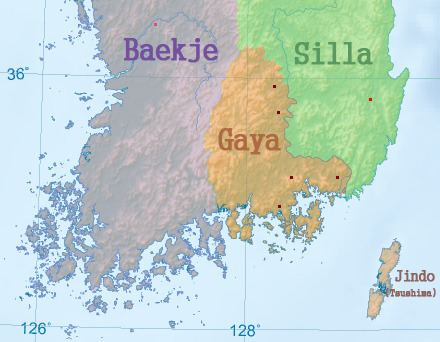 | ||
Mimana (Chinese and Japanese: 任那; pinyin: Rènnà; Korean: 임나), also transliterated as Imna or Yimna according to the Korean pronunciation, is the name used primarily in the 8th-century Japanese text Nihon Shoki, likely referring to one of the Korean states of the time of the Gaya confederacy (c. 1st–5th centuries) as a territory of ancient Japan. As Atkins notes: "The location, expanse, and Japaneseness of Imna/Mimana remain among the most disputed issues in East Asian historiography." Seth notes that the very existence of Mimana is still disputed.
Contents
Usage of the term
The name 任那 (pronounced Mimana in Japanese, Imna in Korean, and Renna in Mandarin Chinese) is used over 200 times in the 8th-century Japanese text Nihongi. Much earlier it is mentioned in the 5th-century Chinese history text the Book of Song in the chapter about the State of Wa. It is also used in two Korean epigraphic relics, as well as in several Korean texts, including Samguk Sagi.
Hypotheses about the meaning
The first serious hypothesis about the meaning of Mimana comes from Japanese scholars, who based on their interpretation of Nihongi made a claim that it refers to a Japanese-controlled state on the Korean peninsula that existed from the time of the legendary Empress Jingū's conquest in the 3rd century to Gaya's defeat and annexation by Silla in the 6th century. This was one of the grounds for portraying the 20th-century occupation of Korea as a Japanese return to the lands they once controlled. This early Japanese view has also been often reproduced in old Western works. One of the main proponents of this theory was Japanese scholar Suematsu Yasukazu, who in 1949 proposed that Mimana was a Japanese colony on the Korean peninsula that existed from the 3rd until the 6th century. This theory has lost popularity since the 1970s.
This old Japanese interpretation has been disputed by Korean scholars. At first they simply chose to ignore it, and later on they have been bolstered as continuing archeological excavations on the Korean peninsula have failed to produce evidence supporting this hypothesis. Korean historians generally interpret the claim about a Japanese colony in Korea as a nationalistic, colonial historiography. Korean scholar Chun-Gil Kim, in his 2005 book The History of Korea, discusses this topic under the section "The Mimana fallacy".
Rurarz describes five main theories about Mimana, starting with Suematsu's. According to her, a second theory about Mimana was proposed by North Korean scholar Gim Seokhyeong, who proposed that it was in fact Koreans who had a colony on Japanese islands, somewhere around Oyama prefecture, and thus Nihongi should be understood as referring only to the Japanese lands, not the Korean peninsula. This is related to the so-called horserider invasion theory in which horse riders from the Korean peninsula are said to have successfully invaded Japan.
A third theory has been proposed by Japanese scholar Inoue Hideo, who argued that ancient Japanese Wa people might have settled a region in the Korean peninsula as long ago as around the Neolithic, and the Mimana state was an enclave of this group.
A fourth theory was put forward by South Korean scholar Cheon Gwan-u, who argued that the events present a history of the Korean Baekje state, which was allied with Japan, and whose leaders escaped there after Baekje's fall in the 7th century. In this version, Mimana would refer to Baekje, or some poorly understood fragment of that state that fought against Gaya. The fifth theory, which Rurarz describes as a "compromise version of recent young Japanese and Korean scholars" argues that there never was a Mimana state as such, and the term refers to Japanese diplomatic envoys active in the Korean peninsula in that era.
According to Han Yong-u, Yamato Japan could have established an office in Gaya in order to export iron to Japan.
The topic of Mimana (such as its portrayal in Japanese textbooks) is still one of the controversies in Japanese-Korean relations.
